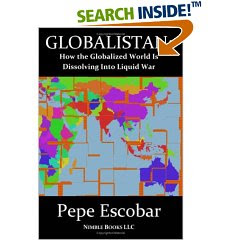In the run-up to the 2004 presidential election, reports were coming in fast and furious about a variety of electoral shenanigans, mostly in Florida and Ohio. Voter disenfranchisement campaigns had started early in Jeb Bush's state and more or less matched those that saw
some 170,000 voters capriciously excluded from the 2000 election. Many or most of them were minorities, traditionally Democratic.
But the warnings about the election machines, happily provided by Deibold and Election Systems & Software (ESS), Chuck Hagel's (R-Nb) former employer, were perhaps the more alarming of the potential developments forseen in 2004. Computer security studies (
Kono et al, 2004) had revealed serious problems ... and were summarily ignored. In the post-mortum of the election, many excuses were made for the amazingly "bad" exit polls that were inexplicably wrong by an unprecedented margin. At least, every excuse was raised except one, the most obvious one to a computer hacker: the machines had been hacked and easily so. The political parties, the mainstream press, and even mainstream blogs like dKos, howled at any such notion. Conspiracy theories! they all wailed. This attitude seemed rooted in only one thing: a belief in the putative integrity of the American democratic process.
The Conyers House Judiciary Commitee investigation,
What Went Wrong in Ohio, revealed a vast array of problems in the vote count in that state and received more the 57,000 sworn complaints from Ohio voters. But recently, the
GAO issued its report of the electronic voting machines and delivered a damning appraisal of the Repubilcan-supplied hacker honey pots: concerns about electronic voting machines have been realized and have caused problems with recent elections, resulting in the loss and miscount of votes. Among the GAO's findings were some startling observations:
-It was possible to alter cast ballots and system logs without being detected.
-It was possible to alter the files that define how a ballot looks and works so that the votes for one candidate could be recorded for a different candidate.
-Vendors installed uncertified versions of voting system software.
-A voting machine in Mahoning County recorded a negative 25 million votes for Kerry.
Oops! Guess that glitch was a little too glitchy. But I really love this one:
-Election officials in Mahoning County now concede that at least 18 machines visibly transferred votes for Kerry to Bush. Voters who pushed Kerry's name saw Bush's name light up, again and again, all day long.
If the issue at hand was not about the civic infrastructure of the United States, it would be almost comical in its reading. Of course, there is nothing at all comical about it. And the evidence that has been gathered and presented is beyond overwhelming.
At this point, it probably wouldn't surprise anyone to learn that the recent local elections in Ohio
saw yet more inexplicable vote count/poll discrepencies. And this time, the results were, quite simply, beyond belief.
There were five ballot initiatives on the ticket this past election day in Ohio, four of which regarded election reform and all of these were polling -- the day before -- with high numbers: 60% and above for, 30+% against. The vote count on election day saw the numbers flip with 60+% of the vote against and 30-odd% for the initiatives. As one might imagine, this was not within the margin of error of the the Columbus Dispatch polls, which have been historically very accurate, usually to within +/-2.5%. But now, suddenly, they were wrong, wrong, wrong. So wrong, in fact, it would make polling appear to be an utterly useless exercise.
But the fact is, polling is not usually very wrong. Polling is an amazingly precise statistical exercise and has been so for sometime. And this is confirmed, oddly enough, by the
very same ballot that saw the four election reform initiatives go down in unexpected yet roaring flames. One of the ballot initiatives had nothing to do with election reform. It was ostensibly a job creation plan, was polling at 54% in favour the day before the election and passed with 53% of the vote.
Now, you might be inclined to think that the Columbus Dispatch would be defending their polls and crying foul. But you'd be wrong. Wrong, wrong, wrong. So credulous is Darrel Rowland, the Dispatch's public affairs editor, that it leads him to
say things like this:
There's always a chance [of electronic fraud] in this crazy day and age, but I don't see how it's realistically possible. There would have to be some super nano-technology.
Well, at least it's good to see he thinks there's "always a chance."
Now, let's examine credulous Darrel's belief that some super, double-plus ungood nano-technology must be the culprit, which to his mind, clearly means that such election machine machinations can't happen. To do this we will revisit one of the GAO's findings:The electronic network on which 800,000 Ohio votes were cast was vulnerable enough to allow a a tiny handful of operatives -- or less -- to turn the whole vote count using personal computers operating on relatively simple software.
Does this sound like "super nano-technology" to you? I'm guessing this whole computer ... thing must be one super big mystery to Darrel.
The credulous denial by Rowland and the faith-based manner in which he contends that nothing like election fraud could happen on these voting machines is what is really hard to understand here. The press used to pounce on stories of election fraud and American politicians have traditionally embraced a spectrum of practices designed to get them more votes than reality would allow. Why is hacking a computer beyond the realm of consideration for these people? Do they not read their own news?
But this isn't just Darrel's problem. This attitude has been seen across the broad spectrum of the mainstream media. Is it that, because of the technology involved, the mainstream feels unqualified to question the results of the new voting technologies? Are they so cowed by a fear of technology that they will rather doubt, vehemently so, traditionally accurate polling practices? That might be part of it.
There is more, however, and naturally enough, it has everything to do with the post-9/11 world. Since that time, the media has been on its back, cooing at every little stroke of Karl Rove's gnarled fingers. It has been improving lately, I think. Not hugely so, but a bit. But they still don't seem up to questioning the electoral process of the "world's greatest democracry," which means that America's democracy is very grave danger.



















